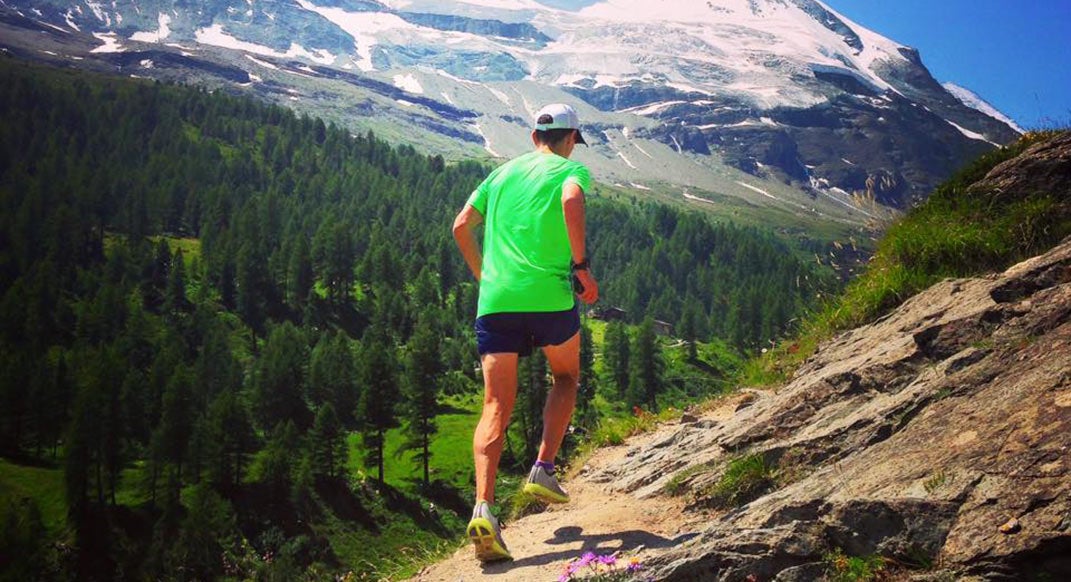Up-Down Intervals: The Number-One Workout for Trail Racing

Running a race on the road or track is like a competition to see who can stay in the sauna the longest. It might be fun at first, sure. But after a while, everything starts to burn, and the competitors only stop when they feel close to death.
Trail racing, meanwhile, is like running through sprinklers as a kid. It tickles and might be uncomfortable at times, but you emerge on the other end giggling deliriously.
The difference between road racing and trail racing is that the two disciplines stress different physiological systems. On the road, you push in a mostly linear way, with incremental increases in heart rate and body breakdown. Thus, a perfect race ends in complete exhaustion.
On the trails, meanwhile, you might max out on an uphill, then recover as the terrain becomes more manageable and even laugh wildly as you jump over a rock/root/mountain lion. Basically, think of it like an EKG. On flat roads, you push until you are flatlining. On trails, your EKG mirrors the terrain—which in most races ends up looking like a nice, healthy heartbeat.
It’s important to understand what makes trail racing different in order to train effectively. Instead of training metronomic efficiency as on roads, you are training the ability to max out and recover multiple times. That undulating effort level requires more muscular strength and a higher anaerobic threshold. (An enhanced ability to giggle like a schoolchild is also encouraged.)
Fortunately, one workout type builds all of those skills and can form the basis of your training schedule: up-down intervals. You can think of these as hill reps with active (and fast) recovery. On up-down intervals, you push hard up and over hills, learning to exert yourself to the point of red-lining on the ups, before recovering on flats and downs while still moving at race pace or faster.
Up-down intervals teach the body to recover while running fast downhill. Photo by Brazen Racing
As your body builds strength and aerobic capacity, you can extend the intervals to work on the essential transition from up to down back to up—a transition that often feels foreign and ruins trail racers that are unprepared. Finally, since the workout has you pushing on downhills, you get faster sections that build trail-specific speed.
There are two essential up-down workouts. As always, start with a good warm-up.
1. Short and Fast
For short-and-fast up-down intervals, find a trail with uphills that take between 30 and 90 seconds (with corresponding downhills that take less time since they’ll be faster), preferably with some flat as well.
After the warm-up, do 15 minutes of intervals in increments of three to five minutes with equal recovery. I prefer five intervals of three minutes with three minutes of walking or jogging recovery between each. The key is to push the uphill portions hard so that you are nearing your limit by the time you reach the top, and then to “woo-hoo” your way down the declines, running them fast as part of the interval while catching some of your lost breath after the uphill. You will see close-to-immediate fitness gains by increasing your muscular strength and anaerobic ceiling.
Do short-and-fast up-down intervals early in your training cycle. They allow you to put your speed to work, and they’ll build resilience for the epic workouts and races to come.
2. Long and Strong
Nope, “long and strong” is not a reference to Sir Mix-A-Lot, though these workouts will leave you “down to get the friction on” in your big race.
Long and strong up-down tempos are extended tempo efforts lasting between 20 minutes and one hour. First, find a trail course with varying ups and downs—you can use a longer loop, repeat a shorter loop multiple times or use one hill and turn around at the top. (This last option should be reserved for the sad souls who live in places without many hills).
Transitions between uphills, downhills and flats are a key trail-racing skill. Photo by David Roche
After a warm up, run sustainably hard for the entire effort, focusing on running the uphills strong and downhills fast without rest. You’ll notice a creeping residual fatigue throughout the workout as your muscles tire from the uphill exertion and downhill pounding. This is good! Fatigue now means less fatigue later at races, when it counts.
Do long-and-strong up-down tempos in the middle and end of your training cycle. Start at 20 minutes and adjust the duration based on your goal race distance. If you are racing a trail 10K, keep it at 20 minutes. If you are racing a half-marathon, peak at 40 minutes. And if you are racing a marathon and up, one hour is perfect.
For both types of up-down intervals, never do more than one set each a week, and pay attention to adequate recovery on ensuing days. With the magic of up-down intervals, you’ll be faster and stronger than ever.
Or (to put it another way) you’ll be singing, I like big hills and I cannot lie.